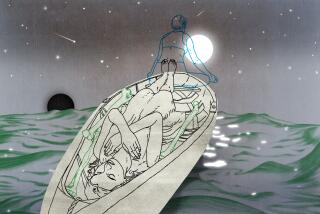Researcher Hoping to Shed Light on Gray Area Between Heaven, Earth
- Share via
CHARLOTTESVILLE, Va. — Dr. Bruce Greyson waited beside the hospital bed of a patient whose stilled heart had been shocked back to life, eager to hear the man’s tales from the threshold of death.
The patient tells of an out-of-body experience--fascinating, but tame compared with many of the visions recounted these days in publications ranging from tabloids to respected medical journals.
Some patients tell of floating out of their bodies, watching themselves on the operating table and then plunging through darkness and toward an intense light. Others report meeting deceased loved ones, having their lives reviewed or encountering an energy they describe as a loving being, or God.
They all recount the fascination with another world, somewhere between life and death. Is it somewhere between this world and another or is it what the dying brain sees on its way to the final unconscious?
This particular patient “felt that he was somewhere above his body, floating weightless,” said Greyson, a professor of psychiatric medicine at the University of Virginia. “He didn’t see his own body or see a light.”
But it is among the best stories heart attack patients have told Greyson and Dr. Ian Stevenson, co-directors of a three-year study at the university into near-death experiences. The project, which began in January and is funded with $250,000 from a German psychiatric institute, will compare the mental and physical development of heart attack patients who report near-death phenomena with those who do not.
Previous studies, including one by a cardiologist in 1980, indicate that about one-third of people who come close to death have transcendental or mystical encounters.
Medical technology allows doctors to resuscitate more clinically dead patients than ever.
But some of them, fearing they will be called crazy or told they are imagining things, won’t discuss their experiences, Greyson said.
However, there are enough survivors who are willing to talk that they’ve formed an association with regional support groups. The International Assn. of Near-Death Studies has been established at the University of Connecticut.
Stevenson and Greyson say most of their colleagues in medicine believe such experiences are hallucinations produced either by drugs, metabolic disturbances or brain malfunctions.
Nevertheless, the stories they tell are so real to them and so consistent that the medical community finds them difficult to ignore, Greyson wrote in a section on near-death incidents in Encyclopaedia Britannica.
“The striking thing is that it is almost universally a light or a tunnel they remember,” said Pamela Dennison, the head nurse in the University of Virginia Medical Center cardiac-care unit. “The other striking thing is how much they resist coming back. The experience on the other side is a much more comfortable one than what they awaken to.”
Many of those who describe near-death episodes say they felt overwhelming peace, painlessness, well-being and an encounter with a loving being, Greyson said.
“There is a fair amount of evidence that people are psychologically different after a near-death experience,” Greyson said. “They generally are less afraid of death, more compassionate, more altruistic, less competitive and less materialistic.”
Greyson, editor of the Journal of Near-Death Studies, and Stevenson, who has collected near-death-experience case studies since 1958, said physical aspects of patients brought back from death have never been examined before.
“There are anecdotes that people sometimes report miraculous healings after near-death experiences,” Greyson said. “They often report they function better.”
He said he thinks the study will show patients improving physically as well as psychologically after near-death experiences.
If medicine can learn enough from these experiences, “we can find ways of replicating the beneficial aspects,” Greyson said. “Some people have attempted to replicate the experiences with guided imagery or hypnotic suggestion.”
Only a handful of American universities study the paranormal.
Greyson and Stevenson said theirs will be the first prospective study--one that begins with a controlled group and follows it over time. Previous studies have been retrospective and are less reliable because they rely on the memories of subjects who come forward.
Along with what Stevenson called a “captive” study group, the Virginia researchers will have access to medical records that can corroborate what patients say about their conditions.
Dr. Ian Sarembock, director of the cardiac-care unit, said it could be difficult for the researchers to develop case studies because most people whose hearts stop either die or suffer brain damage. “Few actually survive to tell the tale.”






